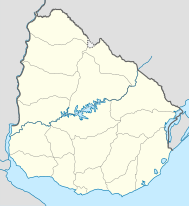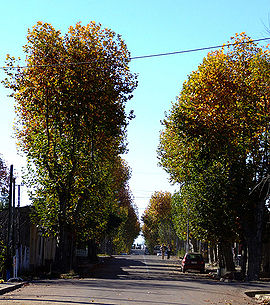Melo
| Melo | ||
|---|---|---|
|
Coordinates: 32 ° 22 ′ S , 54 ° 10 ′ W Melo on the map of Uruguay
|
||
| Basic data | ||
| Country |
|
|
| Department | Cerro Largo | |
| City foundation | June 27, 1795 | |
| Residents | 51,830 (2011) | |
| City insignia | ||
| Detailed data | ||
| height | 111 m | |
| Post Code | 37000 | |
| prefix | +064 | |
| Street in Melo | ||
| House of Juana de Ibarbourou in Melo | ||
Melo is a city in northeastern Uruguay .
geography
It is located on the Arroyo de Los Conventos river, only 60 km from the Brazilian border, in the center of the Cerro Largo department , of which it is the capital. The distance to the Uruguayan capital Montevideo is 387 km.
history
Melo was founded on June 27, 1795 by Agustín de la Rosa as a Spanish military post. The city got its name after the viceroy of the Río de la Plata, Pedro de Melo de Portugal y Villena (1733-1798), who was in office from 1795 to 1797 . When Uruguay gained independence, Melo became the provincial capital. On May 22nd, 1895, Melo was given the status of " Ciudad " by Law No. 2,327 .
On November 15, 1955, today's diocese of Melo was established with its seat in Melo. In 1988 Pope John Paul II visited the city.
Infrastructure
education
Melo has a total of three secondary schools ( Liceo ). These are the Liceo Nº 1 Departamental "Juana de Ibarbourou" (3,330 students) founded in 1912 , the Liceo Nº 2 "Justino Zavala Muniz" (929 students) , which started teaching in 1977, and Liceo Nº 3 (857 students), which has been in existence since 1992 . (Status: 2008)
Culture and sights
With the great immigration of Brazilians from Rio Grande do Sul in the mid-19th century, the culture, the way of life and even the language in Melo have merged with the Brazilian. One finds in Melo a unique originality and an identification with old Brazilian traditions, such as carnival and spring dances.
Sights include the city's most important square, in the middle of which there is a monument to General José G. Artigas with his statue. This square is named Plaza Constitución after it was originally known as Plaza Vieja . It has been declared a Monumento Histórico Nacional . It is surrounded by the police headquarters of the Department of Cerro Largo , the Iglesia Catedral built in 1876 , the Club Unión de Melo and many houses built in the 19th century. The station CW 53 La Voz de Melo and Canal 12 Melo TV are also located here. Another important place is that of the Grail streets . Justino Muniz , Florencio Sánchez , Agustín de la Rosa and Colón bordered Plaza Independencia . There is in the Melo a few blocks from the city center near the Liceo No 1 location, with a monument in honor of General Aparicio Saravia provided Plaza Aparicio Saravia . Furthermore, sometimes referred to as exists Plaza de las Carretas called Plaza Dionisio Coronel .
Sports
The Uruguayan football club Cerro Largo FC is based in Melo and plays its home games at the Estadio Municipal "Arquitecto Antonio Eleuterio Ubilla" .
traffic
The Uruguayan highways Ruta 8 and Ruta 26 intersect in Melo . The city also has an air connection with Cerro Largo Airport, twelve kilometers northwest of the city .
Residents
The city has 51,830 inhabitants (as of 2011), of which 24,517 are male and 27,313 are female. A large part of the population of the department, which itself only has 84,698 inhabitants (as of 2011), therefore lives in Melo.
| year | Residents |
|---|---|
| 1963 | 33,387 |
| 1975 | 38,487 |
| 1985 | 42,245 |
| 1996 | 46,883 |
| 2004 | 50,578 |
| 2011 | 51,830 |
Source: Instituto Nacional de Estadística de Uruguay
sons and daughters of the town
Footballer:
- Mauricio Affonso (* 1992), football player
- Martín Alaníz (* 1993), football player
- Rodrigo Alaníz (* 1992), football player
- Pablo Bentancur (* 1989), football player
- Leonardo Burián (* 1984), football player
- Gonzalo Castillo (* 1990), football player
- Ayrton Cougo (* 1996), football player
- Diego De Souza (* 1984), football player
- Enrique Etcheverry (* 1996), football player
- Alejandro Furia (* 1994), football player
- Dany González (* 1985), football player
- Bernardo Laureiro (* 1992), football player
- Adolfo Lima (* 1990), football player
- Rino Lucas (* 1980), football player
- Salvador Maidana (* 1987), football player
- Ademar Martínez (* 1990), football player
- Luis Morales (born 1997), football player
- Pablo Olivera (* 1987), football player
- Juan Jacinto Rodríguez (* 1958), Uruguayan football coach
- Bruno Silva (* 1980), football player
- Nicolás Sosa (* 1996), football player
- Sebastián Sosa (* 1994), football player
other:
- Ildefonso Aroztegui (1916–1988), architect
- Salvador Betervide (1903-1936), politician
- Vladimiro Collazo (* 1933), artist
- Villanueva Cosse (* 1933), actor, director, writer
- Andrés Echevarría (* 1964), writer
- Tabaré Etcheverry (1945–1978), singer and composer
- Gley Eyherabide (1934-2015), writer
- Enrique Fernández (* 1953), director
- Juana de Ibarbourou (1895–1979), poet
- Casiano Monegal (1885–1944), writer
- Emilio Oribe (1893–1975), writer
- Saviniano "Nano" Pérez (1907–1985), politician
- Villanueva Saravia (1964–1998), politician
- Amalia de la Vega (1919-2000), singer
- Eber da Rosa Viñoles (1949–1997), politician
- Justino Zavala Muniz (1898–1968), writer, politician
Others
Melo is the setting for the award-winning film " El baño del Papa - The Big Business ", which premiered at the 2007 Cannes Film Festival .
Web links
- City map of Melo (PDF; 224 kB)
- Diocese of Melo
Individual evidence
- ^ "Placenames of the world: origins and meanings of the names for over 5000 ...", p.232 by Adrian Room
- ↑ Montevideo - "RESEÑA HISTÓRICA Y DATOS VARIOS" - Visitas de Juan Pablo II in the lower quarter of the website ( Memento of the original of March 2, 2009 in the Internet Archive ) Info: The archive link was automatically inserted and not yet checked. Please check the original and archive link according to the instructions and then remove this notice. (Spanish)
- ↑ Liceos del Uruguay (Spanish) (PDF; 7.3 MB), accessed on February 29, 2012
- ↑ La Ciudad de Melo
- ↑ Statistical data ( memento of the original from October 19, 2013 in the Internet Archive ) Info: The archive link was inserted automatically and has not yet been checked. Please check the original and archive link according to the instructions and then remove this notice. of the Instituto Nacional de Estadística de Uruguay , accessed on September 22, 2012
- ↑ Statistical data of the Instituto Nacional de Estadística de Uruguay 1963–1996 (DOC; 78 kB)
- ↑ Statistical data of the Instituto Nacional de Estadística de Uruguay (PDF; 622 kB)
- ^ "El baño del Papa - The big business" on kino-zeit.de




